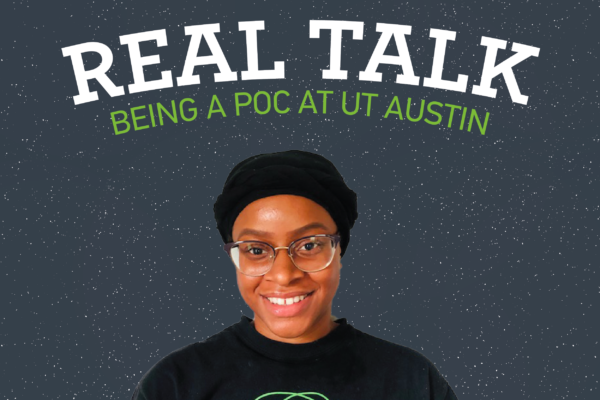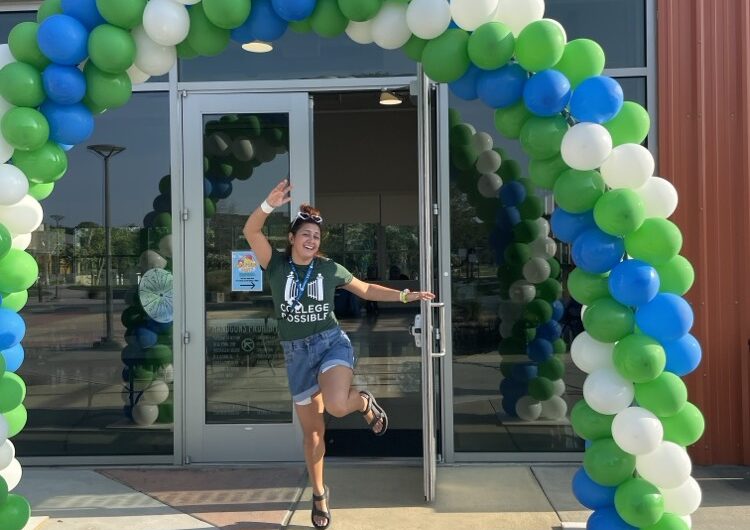The blog series: Real Talk: Being a POC at a PWI spotlights the stories and experiences of College Possible students of color. These stories are not indicative of every student of color’s experience at their PWI. However, other students of color reading may find parallels in these accounts. Due to having similar experiences at their respective campuses. Every person’s story carries value in the holistic experience colleges have to offer. Thank you, Alexis, for writing about your personal experiences at The University of Texas at Austin (UT Austin).
……………………………………….
As a native to Austin, it was always my dream when I graduated high school to be independent – that is to experience life outside of home. And college, for me, was my one-way ticket to experiencing this “freedom.” To ensure this independence that I was so hardwired on, all my senior year college applications were outside the Austin area. Colleges like Huston-Tillotson, St Edwards, and The University of Texas of Austin were not on my radar. Not only was I unwilling to let go of any chance of independence (by my definition), but my scores for the ACT and SAT weren’t as high as I’d hoped – so I was advised not to apply for schools like these. The entire process itself was overwhelming, from the tests to the application fees, to filling out FAFSA, I began to feel discouraged.
It wasn’t until I received award letters from my schools that reality hit – I really couldn’t afford to leave home. According to the FAFSA, my parents fell into the median income bracket. Because of this, the amount of grant money FAFSA awarded me for each semester was low, with most of my support from financial aid being federal loans. Even though accruing debt is inevitable for most people, I wanted to make a more responsible decision. On top of this, I hadn’t received any scholarships that I applied for throughout the year. And although my family and I were not in the low bracket for income, the estimated family contribution did not accurately reflect what my parents could afford. The truth is, I was expected to find work and pay for my own tuition, and they promised to help me out in other areas of life. With all of this in mind, I concluded that attending a four-year institution may not be the best option, especially if I had to come up with expenses on my own.
My goal of leaving home was no longer realistic in the moment, but I still had hope for the future. I needed to rearrange my plans. I decided that a more affordable route would be to attend a community college and then transfer to a four-year institution outside of home – just like I’d desired. I ended up applying to Austin Community College and stayed there for two years. Staying in Austin no longer was something that I had questioned was the right decision. I realized that there were so many benefits to being at home. I met so many great people, I could see my family, and I did not have to pay rent, which allowed me to save money for my future.
I feared not being able to find a community because of my race. I always knew what a PWI was. All our college tours in high school were at institutions where the demographic majority was white but living in the experience was different.
Being at home fostered an environment for me to succeed, and I did. At ACC, I had done so well with my grades that I opened a broader opportunity of colleges to apply for. After my second year at ACC, I knew that I had to start preparing for transfer during my Fall semester. As the Spring of 2019 began to approach, I started my application process. By this time, my entire mentality of leaving Austin and being independent had changed – I realized that I had independence right here at home. I knew that traveling was something I could do in the future, so I decided to apply to the school that I never had on my radar before. I applied to The University of Texas at Austin. Later that summer, I received my acceptance letter stating that I could attend in the Fall of 2019. I was shocked but eager to enter the next season of my life as a Longhorn.
While the last couple of years felt like a series of successes for me, it seemed like once I got my foot through one door, another came spiraling up. The constant flood of “doors” for me was the difficulty of transitioning over to UT. It wasn’t the same. I felt alone, even in the sea of 50,000 other people. Even though I had a record of all A’s at ACC, I still doubted my competency. I feared not being able to find a community because of my race. I always knew what a PWI was. All our college tours in high school were at institutions where the demographic majority was white but living in the experience was different. This fear became all-encompassing at orientation. There was this sharp sense of pride in the auditorium where we gathered. The anxiety I felt followed me everywhere that day, as I was consistently reminded of why I should be proud to be a Longhorn.
During the presentations, the singing, and the performances, I was fighting with guilt and confusion. Why wouldn’t I be grateful to be at a University that is full of so many opportunities and resources for its students to succeed? But at the same time, how could I feel this pride when there were only a handful of others in a sea of a hundred students who looked like me? I understood that we all shared similar experiences as transfer students; however, there were many other experiences as a Black female, that they could share among each other that were not unique to my own. As orientation continued, I began to pinpoint more instances in which I felt ostracized as a Black person. The first was the auditorium. Still, as we started to do events throughout the day, it surrounded me – the number of Black transfers was scarce. When I attended more events during orientation, specifically the student organization fair, no Black student orgs were tabling at the time.
I felt motivated to make a change. At this moment, I realized that all the experiences in which I felt ostracized were an impetus for my desire to create a difference, find my broader community, and help others do the same.
Even though I knew some existed, from my research prior – it only added to my discouragement. After visiting various tables, I sat alone on the side – I did not know anyone there, and I just felt like sitting. Two Black women were standing next to me, who looked like they were helping with the org fair. One of them asked me what my name was – she must’ve seen the look on my face because after I told her, she proceeded to say, “Black UT exists, there is a community here for you.” Hearing that at that moment was needed more than I’d realized. It gave me a greater sense of hope. We continued talking, sharing our social media with each other, and she let me know the latest events that were happening for Black students, and I made sure to make a note of each one so that I could try to attend.
As the Fall semester continued, the feeling of being alone wasn’t as heavy; it still existed, though. I didn’t want to be pessimistic, so I tried to find the positive, but it wasn’t hard to notice and feel like the minority. Black students on campus only represented 4% of the population, and it was visible pretty much everywhere I went. As I walked to class, sitting in class lectures where I was number 5 out of the 150+ students in the room. I realized that I had to try to place myself in spaces that were intentionally created to support the Black community. Luckily, this intention began before I even got to UT. In the summer, when I was registering for classes, I chose to register for an upper-division psychology class called “The Psychology of the African-American Experience.” As a psychology major and a Black person, not only was this a topic that intrigued me, but this class became a space where I felt seen. It was surely a gem to be in a course where most of my peers shared my same ethnic and cultural background. It felt like home.
We were told the first day, though, by our professor, Dr. Cokley, that if we were psychology majors, this class wouldn’t count towards our major. I couldn’t help to wonder why, so I set an appointment with my advisor to find an answer within that week. He told me that this course wasn’t considered (by the psychology department) “pure psychology.” It made sense logistically why they said this because the class offered wasn’t offered through the College of Liberal Arts but through a separate college under a graduate program. On the other side of things, it didn’t make sense that a class discussing my race’s psychology wouldn’t be counted. I felt confused and then frustrated; it felt like UT had neglected the opportunity to recognize a diverse curriculum. However, my discouragement this time sat differently – I wanted to do something about it. I felt motivated to make a change. At this moment, I realized that all the experiences in which I felt ostracized were an impetus for my desire to create a difference, find my broader community, and help others do the same.
Our existence has incited growth in UT as an institution. There has been much progress, but there is still much room for more. If you are a prospective student at UT, who identifies as Black, know that your journey is as a role model and hope to someone else in our community.
My journey of influencing change started first internally – I strived to establish my ground as a minority student, which meant stepping out and denying any sense of complacency. I began to understand that my Blackness was (and still is) an indelible part of my identity and that yes, representation fatigue is real. But with the acceptance of my uniqueness, I could represent, bring hope to others, and transform areas where I felt my community lacked recognition and representation. I started to attend multiple Black organization meetings throughout the year. I came across UT’s ABPSI (The Association of Black Psychologists) and TGF (Texas Gospel Fellowship). These were communities where I could actively learn about my culture, my identity, and volunteer to help in my community. It’s also important to note because of the history at UT, there were spaces created intentionally by the institution to help foster support in minority communities, so I began to do my research. I found the Multicultural Engagement Center or (MEC), the African American Culture Room in the Texas Union, The Malcolm X Lounge, and the Gordon White Building. I used all these spaces to my advantage to help me establish a greater sense of belonging, and they continually reassured me that I wasn’t alone through this journey.
This upcoming year will be my Junior year at UT, and I can say that the student who told me that at orientation was right – Black UT does exist, and our community is strong. Our existence has incited growth in UT as an institution. There has been much progress, but there is still much room for more. If you are a prospective student at UT, who identifies as Black, know that your journey is as a role model and hope to someone else in our community. I never thought that I’d become a leader in a Black organization on campus, but I am. I can use my race to help support and build my community. So it’s essential to know and understand that there will be bumps along the way. But remember that just because an aspect of your ethnicity is not widely spread across campus across does not mean that it is less of, or underappreciated, but that it is unique to your college experience.



